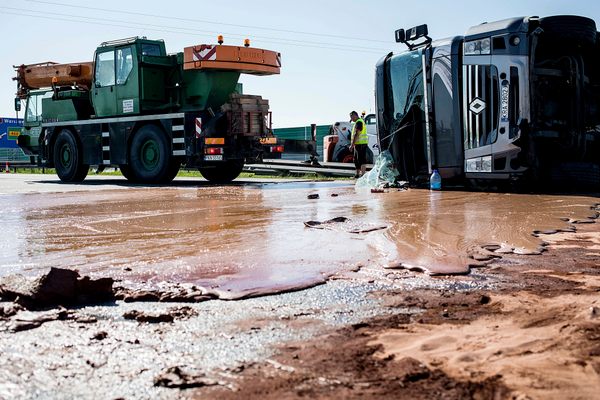An Incomplete if Exhaustive Tally of Recent Highway Truck Spills
From bees to beers.
Bread truck collides with deli meat truck in New Jersey https://t.co/OMPa8y89IM pic.twitter.com/a6wH9WI05t
— Austin Statesman (@statesman) June 20, 2016
On Friday, a truck carrying deli meat and a truck carrying bread crashed into each other—apparently unintentionally, though lots of sandwich jokes ensued—on a highway in New Jersey. The consequential wreckage included a not unfamiliar scene: food scattered all over the highway. Perfectly good food, that is. Lots of sad potential sandwiches.
On the highway, tractor-trailers move like elephants, pacing along in the right lane, barely noticeable except for their size, their contents as mysterious as their destination. But in disaster they are, like all of us, completely unspooled. There is no more mystery, just utter vulnerability.
Compelling photos may explain why a truck carrying deli meat crashing into a truck carrying bread will always make the news. Just a few days before the meat-bread collision, for example, a truck in China got into an accident and hundreds of baby chickens were let loose. But truck spills themselves obey few laws: they can happen at anytime, and no cargo is safe.
By this Friday, an event like this will likely have happened again: a tractor-trailer, full of Twinkies or kittens or makeup, makes a wrong turn, or is forced into an overcorrection, and wipes out, baring its contents to the world.
Let’s start by looking at May of this year, when one of the worst truck spills in recent memory unfolded. It was a so-called “flash spudding,” after a truck driver fell asleep at 2 a.m. and his truck overturned in North Carolina, spilling 50,000 potatoes onto thousands of feet of roadway. Snow plows were later brought in to clean it up.
ALERT: Mash destruction on I-77 SB at West Blvd. CLOSED. Thousands of potatoes on roadway #cltraffic #clt pic.twitter.com/mPaoQvS98l
— Traffic Team 9 (@TrafficTeam9) May 6, 2016
Just a month before, a huge amount of what appeared to be red potatoes spilled out of a truck in Massachusetts. Potatoes, highways, and trucks, it seems, don’t mix well.
This month, a tractor-trailer carrying onions tipped over in Riverside, California, completely covering a roadway in the white vegetables.
Onion truck crash closes California highway https://t.co/WxMkv8ii8a pic.twitter.com/DAFWwZyzBe
— FOX 32 News (@fox32news) June 9, 2016
And in April, a tanker truck in Virginia spilled roughly 5,300 gallons of milk onto the roadway, closing the road and requiring the services of a hazardous materials team. (Authorities said the hazmat team was for spilled fuel, not milk, but one can never be too sure.)
Also in April: some sausage ended up on the road in Minnesota, and, dangerously, 2,200 gallons of gas was absorbed into the ground after a wreck in Missouri. Massive wind turbine parts met their end in Colorado. A bunch of logs clattered to the pavement in Michigan after a truck driver lost control of his ride.
March, meanwhile, saw a frathouse-inspired precursor to the deli-meat and bread truck collision, when a truck carrying Doritos crashed into a truck carrying Busch beer on a highway in, yes, Florida. A beer truck in Texas met a similar fate later in the month, though this time no chips were involved.
In Minnesota, a grain truck lost its grain, though a local television station seemed nonchalant: “MANKATO: Update on grain truck spill.” (They’ve seen this movie before.) In Washington state, one unfortunate highway hosted 27 tons of chicken poop. More worryingly, liquid nitrogen was spilled in Tennessee.
February, for its part, brought some farce, when, in James County, Virginia, a truck carrying furniture crashed, throwing it onto the highway, and prompting a tractor-trailer carrying bacon behind it to lose control and drive off into the woods. Perhaps this spillage would not clutter up the road, but lie in nature. But it wasn’t to be. As officials were towing the bacon truck out, they lost control of it, and bacon spilled onto the roadway while the truck rolled back into the woods. Also that month: some lemons were tossed across the highway in a deadly crash.
If 2015 is any indication, though, 2016 probably has some catching up to do, because last year was a strong one for truck spills. Very strong.
Truck carrying Ramen Noodles crashes. Estimated loss to the company: $38.00 pic.twitter.com/Rk7QwkRlz7
— WORLDSTARHIPHOP (@WORLDSTAR) June 18, 2016
Among the things that spilled: ramen noodles under a bridge in North Carolina; ammonium nitrate, which can be used for bombs, in Missouri; 80,000 pounds of human excrement in California (it was headed for a treatment plant); around 1,200 gallons of gas in California; a lot of printer ink on a highway in Virginia; exactly 6,500 gallons of yellow paint in Maryland; in Minnesota, a mysterious “liquid” spilled, reported to be slippery; concrete spilled over a quarter-mile stretch of highway in North Carolina; Budweiser beer all over a roadway in Florida, shutting it for three hours (the truck driver said he was distracted by a small dog he kept in the cab); lug nuts fell out of a truck in, appropriately, Detroit; some bananas in New Jersey; and, perhaps worst of all, some Twizzlers perished in Pennsylvania.
A pile of dead bees near the collision. #beenado pic.twitter.com/pbArHI8qQG
— Evan Bush (@evanbush) April 17, 2015
But the most apocalyptic truck spill of 2015 came early, in April of that year, when 14 million bees were let loose on a highway in Washington state, creating a nightmare.
Firefighters fought the bees with jets of foam and water, but everyone, from motorists to TV news reporters, felt their wrath.
“Everybody’s been stung,” a police sergeant told the Seattle Times then. “This is a first.”







Follow us on Twitter to get the latest on the world's hidden wonders.
Like us on Facebook to get the latest on the world's hidden wonders.
Follow us on Twitter Like us on Facebook